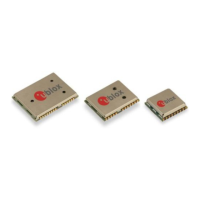LEA-6 / NEO-6 / MAX-6 - Hardware Integration Manual
UBX-14054794 Production Information Design-in
Page 37 of 85
2.4.2 Pin description for MAX-6 designs
Max allowed ripple on VCC=50 mVpp
Assure a good GND connection to all GND pins of the module,
preferably with a large ground plane.
Backup voltage input pin. Connect to GND if not used.
GPS signal
input from
antenna
The connection to the antenna has to be routed on the PCB. Use a
controlled impedance of 50 to connect RF_IN to the antenna or
the antenna connector. DC block inside.
Output Voltage
RF section
Can be used for active antenna or external LNA supply.
Active antenna or ext. LNA control pin in power save mode. Int.
pull-up resistor to VCC
UART, leave open if not used, Voltage level referred VCC_IO. Can
be configured as TX ready indication for the DDC interface.
UART, leave open if not used, Voltage level referred VCC_IO
Leave open if not used, Voltage level referred VCC_IO
Leave open if not used, Voltage level referred VCC_IO
DDC Data. Leave open, if not used.
DDC Clock. Leave open, if not used.
IO supply voltage Input must be always supplied. Usually connect to
VCC Pin 8. If I/O level should be different from VCC, supply VCC_IO
with the I/O level required.
Must be connected to VCC always. Can be used as reset input pin
with additional circuit (connected to VCC by 3.3 k resistor). See
section 1.7.1
Table 16: Pinout MAX-6
2.5 Layout
This section provides important information for designing a reliable and sensitive GPS system.
GPS signals at the surface of the Earth are about 15 dB below the thermal noise floor. Signal loss at the antenna
and the RF connection must be minimized as much as possible. When defining a GPS receiver layout, the
placement of the antenna with respect to the receiver, as well as grounding, shielding and jamming from other
digital devices are crucial issues and need to be considered very carefully.
2.5.1 Footprint and paste mask
Figure 29 - Figure 34 describe the footprint and provide recommendations for the paste mask for u-blox 6 LCC
modules. These are recommendations only and not specifications. Note that the Copper and Solder masks have
the same size and position.
To improve the wetting of the half vias, reduce the amount of solder paste under the module and increase the
volume outside of the module by defining the dimensions of the paste mask to form a T-shape (or equivalent)
extending beyond the Copper mask. For the stencil thickness, see section 3.2.1.

